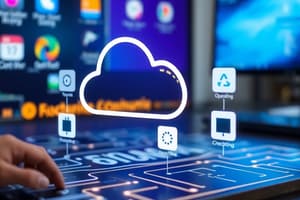Podcast
Questions and Answers
Which of the following scenarios represents the most significant challenge for organizations transitioning to Software as a Service (SaaS) model?
Which of the following scenarios represents the most significant challenge for organizations transitioning to Software as a Service (SaaS) model?
- Ensuring seamless integration with existing legacy systems while maintaining data security and compliance. (correct)
- Adapting to standardized software versions and feature sets, which may not fully align with unique business requirements.
- Difficulty in attracting and retaining IT staff due to reduced complexity in managing in-house systems.
- Overcoming the initial capital expenditure associated with subscribing to SaaS offerings.
The primary advantage of using proprietary software over off-the-shelf software lies in the reduced upfront costs associated with development and maintenance.
The primary advantage of using proprietary software over off-the-shelf software lies in the reduced upfront costs associated with development and maintenance.
False (B)
Explain how the transition from mainframe computers to personal computers influenced Microsoft's dominance in the business software market.
Explain how the transition from mainframe computers to personal computers influenced Microsoft's dominance in the business software market.
Businesses chose continuity by investing in Microsoft OS and applications, and Microsoft capitalized by developing a network OS and business-focused programs as the PC replaced mainframes.
A key advantage of cloud computing is ______, allowing companies to easily adjust resources based on demand.
A key advantage of cloud computing is ______, allowing companies to easily adjust resources based on demand.
Match the following software types with their respective characteristics or functions:
Match the following software types with their respective characteristics or functions:
What is the significance of the "killer app" concept in the history of personal computing, and which type of application is often credited with popularizing the personal computer?
What is the significance of the "killer app" concept in the history of personal computing, and which type of application is often credited with popularizing the personal computer?
Virtualization primarily aims to increase electricity demand and the costs associated with cooling physical servers in data centers.
Virtualization primarily aims to increase electricity demand and the costs associated with cooling physical servers in data centers.
Explain the fundamental difference between desktop software and enterprise software in terms of their intended user base and functionality.
Explain the fundamental difference between desktop software and enterprise software in terms of their intended user base and functionality.
The increased risk of security vulnerabilities in open-source software is counterbalanced by its potential for faster ______ due to community oversight.
The increased risk of security vulnerabilities in open-source software is counterbalanced by its potential for faster ______ due to community oversight.
Match the following software licensing models with their respective core principles:
Match the following software licensing models with their respective core principles:
Flashcards
Software
Software
A set of instructions that tells the hardware what to do.
Operating Systems
Operating Systems
Manages hardware and interfaces between hardware and user; creates a platform for additional applications.
Application Software
Application Software
Performs specific tasks for the user.
Types of application software
Types of application software
Signup and view all the flashcards
Desktop Software
Desktop Software
Signup and view all the flashcards
Enterprise Software
Enterprise Software
Signup and view all the flashcards
Cloud Computing
Cloud Computing
Signup and view all the flashcards
Software as a Service (SaaS)
Software as a Service (SaaS)
Signup and view all the flashcards
Open-Source Software
Open-Source Software
Signup and view all the flashcards
Virtualization
Virtualization
Signup and view all the flashcards
Study Notes
Chapter Introduction
- Computer hardware is information technology that can physically be touched
- Software makes computing happen by providing instructions to the hardware
Learning Objectives
- Define software
- Describe the two primary categories of software
- Cloud computing advantages and disadvantages for use in an organization are covered
- Ways to obtain software are listed
- Open-source definition and characteristics are identified
Operating Systems
- Software is divided into Operating Systems and Application Software
- Operating systems manage the hardware and create the interface between the user and the hardware
- These create a platform for programmers to write additional applications
- Application software performs specific tasks for the user
Operating System Functions
- Manage hardware resources
- Provide user-interface components
- Offering a platform for software developers to write applications
Operating Systems Examples
- Microsoft Windows, Apple’s Mac OS, and various versions of Linux are popular for personal computers
- iOS (Apple) and Android (Google) run smartphones and tablets
Microsoft and Apple
- Microsoft provided first OS for IBM-PC in 1981 and a GUI OS in 1985 known as Windows
- Apple introduced the Macintosh computer in 1984 with the first commercially successful GUI
- Apple’s OS is known as “Mac OS” and recent versions are named after California locations
Linux and Microsoft Dominance
- Linux is open source that runs on large and expensive minicomputers
- Linux was developed by Linus Torvalds and powers a large percentage of web servers
- Microsoft’s Windows controls 71% of the market, and their productivity software, Office 365, has 48% of the market share
Application Software
- Application software accomplishes specific goals such as word processing, or surfing the internet
- Software is divided into productivity, multimedia, home, or communication and collaboration
Productivity Software Functions
- Word processing creates and edits documents with text formatting, tables, and images
- Spreadsheet software does calculations and analysis displayed in charts and graphs
- Presentation software creates slideshows with text, images, audio, and video
- Database management systems serve as electronic filing cabinets for records
Productivity Software cont.
- Desktop publishing combines word processing, graphics, and page layout software to create documents
- Financial software compiles accounting and financial data and creates financial statements and reports
- Microsoft Office is a productivity bundle that dominates the market
The “Killer” App: Spreadsheets
- A killer application is essential and makes people buy a device to run that application
- The first spreadsheet was created by an MBA student at Harvard University and named Microsoft Excel
Collaborative Systems
- Systems began to allow employees to begin collaborating as organizations implemented networking technologies
- Video conferencing with Zoom or WebEx provide collaboration, document sharing with Microsoft SharePoint or Teams, and project management with SAP
- Google Drive offers a suite of office applications that can be shared between individuals
Utility Software and Programming Software
- Utility software fixes or modifies computer and includes software like anti-malware
- Programming software allows developers to write, test, and compile code, identified as the Integrated Development Environment (IDE)
Desktop and Enterprise Software
- Desktop software is installed on personal computers
- Enterprise software addresses the needs of multiple users in an organization
- Enterprise Resource Planning (ERP) software coordinates and integrates business functions and vendors include SAP and Oracle
Enterprise Software and DBMS
- Most enterprise software works with a database management system (DBMS)
- Many ERP systems and enterprise software programs share the same database system for a common data set
Mobile Software and Apps
- Smartphones and tablets use mobile apps which are software applications designed to run specifically on a mobile device
- The number of mobile apps in the Apple App Store has increased from zero in 2008 to over 2 million in 2017
Cloud Computing
- Cloud computing makes applications, services, and data storage accessible through the internet
- Software as a service (SaaS) is rented rather than purchased and allows companies to access software packages without investing in hardware to install and maintain software
Advantages of Cloud Computing
- No software to install or maintain, accessible from any computer with Internet, scalable, quick to set up, services can be leased for a limited time
- Information is not lost if hardware crashes, and not limited by computer memory/disk space
Disadvantages of Cloud Computing
- Information is stored on someone else’s computer, requires internet access, reliant on a third-party
- Automatic upgrades can cause user confusion and AWS is the largest on-demand services
Private Cloud and Virtualization
- For private cloud, a cloud service provider sections off web server space for a specific organization to have full control
- Virtualization is using software to simulate a computer, where a single physical computer can perform the functions of multiple virtual computers
Obtaining Software
- Software is developed internally as proprietary software, or purchased off-the-shelf as packaged software
- Proprietary software is for a specific problem and is owned by the company
- Off-the-shelf software is readily available and already developed
Proprietary Software Advantages
- Users get exactly what they need
- Control over the process
Proprietary Software Disadvantages
- Significant investment (time and money)
- Need to provide ongoing support and maintenance
Off-the-shelf Software Advantages
- Initial cost is lower
- Usually will meet the basic needs of the organization, and customize
- Support and training available
Off-the-shelf Software Disadvantages
- Might pay for features that are not needed or wanted
- Software may lack required features and customization can be costly
Software Creation and Ownership
- Software is created via programming or coding
- Modern software applications are written using Java, Visual C, C++, and Python programming languages
- Software is made available through restrictive software licensing, which requires payment for software
- When installing software, users are being given a license to use it, and agreeing to the terms of service or the license agreement
Open Source Software
- The source code is not available to others to use or copy with closed source software
- Open-source software makes source code available for anyone to copy, use, and is available in a compiled format for download/installation
- The open-source movement has led to software like Firefox, the Linux operating system, and the Apache web server
Advantages of Open-Source
- The software is available for free
- The software source code is available, and can be examined/reviewed before installed
- The large community of programmers provide quick bug fixes and feature additions
Disadvantages of Open-Source
- Technical support is not available similar to traditional software products
- Software companies provide updates when required
- The user interface may be more challenging to use
Summary Notes
- Software gives the instructions to tell the hardware what to do
- Two basic categories of software: operating systems and applications
- Operating systems interface with hardware and make system resources available
- Application software focuses on the work of a user or an organization
- Desktop applications are designed for a single user; enterprise software supports multiple users
- These are accessible from the interne via web browsers
- Cloud computing provides access to software and databases
- Service category that gives companies access to software packages without investing
- Functions shifted to the cloud including cost savings, speedy delivery of software, scalability, employee mobility, and a reduction in information technology staff
- Software can be built (proprietary) or purchased (off-the-shelf)
- Open source software makes the source code available for anyone to copy
Studying That Suits You
Use AI to generate personalized quizzes and flashcards to suit your learning preferences.



